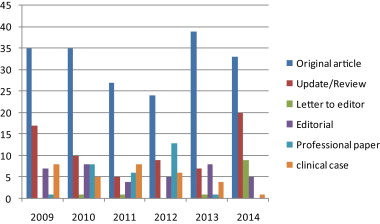1
English version
The current issue is the last French/English bilingual issue of the Annals of Physical and Rehabilitation Medicine ( Annals of PRM ), and the time has come to take stock of six years of publication in the two languages. As indicated and explained in a previous note , our journal is taking a further step towards internalization. As of January 2015, it will only publish papers written in English. This decision by the Journal’s board of directors is aimed at strengthening the position of the Annals of PRM among rehabilitation journals.
From January 2009 through November 2014 the Annals of PRM has published 371 texts, of which the typology is detailed in Fig. 1 . Among these contributions, original articles represent 52%, update/review papers 18%, editorial notes 10%, papers describing clinical cases 9%, professional papers 8%, and letters to the editor 3%.

After the bilingual version of our journal was launched in 2009, an unforeseen and unfortunate if temporary consequence was a sharp drop in the number of downloads by French readers, who probably failed to understand that they could still consult articles written in their native tongue . Slowly but surely this trend was reversed and we finally registered a huge increase in the number of downloads, what’s more on all continents. International readership has had a highly positive impact on the journal’s bibliometry, the papers published being more and more frequently cited . A number of articles have been cited many times, as attested to by Table 1 , which indicates the 10 most cited titles. Most were published in 2009, many were review/updates and one was an original article . Few published papers failed to be cited. These favorable results in terms of bibliometry make us reasonably optimistic for the future.
| Title | Authors | Year | Type of article | Number of citations (scopus) |
|---|---|---|---|---|
| Rehabilitation of arm function after stroke. Literature review (Short Survey) | Oujamaa L, Relave I, Froger J, Mottet D, Pelissier JY | 2009 | Review/update | 70 |
| Electronic tracking system and wandering in Alzheimer’s disease: a case study | Faucounau V, Riguet M, Orvoen G, Lacombe AB, Rialle V, Extra J, Rigaud AS | 2009 | Clinical case | 27 |
| The value of instrumental gait analysis in elderly healthy, MCI or Alzheimer’s disease subjects and a comparison with other clinical tests used in single and dual-task conditions | S. Gillain S, Warzee E, Lekeu F, Wojtasik V, Maquet D, Croisier JL, Salmon E, Petermans J. | 2009 | Review/update | 23 |
| Neuromuscular fatigue in healthy muscle: underlying factors and adaptation mechanisms | Boyas S, Guével A | 2011 | Review/update | 22 |
| Non-steroidal anti-inflammatory drugs for athletes: an update | Ziltener JL, Leal S, Fournier PE | 2009 | Review/update | 22 |
| Education in the management of low back pain. Literature review and recall of key recommendations for practice | Dupeyron A, Ribinik P, Gélis A, Genty M, Claus D, Hérisson C, Coudeyre E | 2011 | Review/update | 21 |
| The field of competence of the specialist in physical and rehabilitation medicine (PRM) | Gutenbrunner C, Lemoine F, Yelnik A, Joseph PA, de Korvin G, Neumann V, Delarque A, Yelnik AP, Simon 0, Bensmail D, Chaleat-Valayer E, Decq P, Dehail P. | 2011 | Professional paper | 20 |
| Drug treatments for spasticity | Quentin V, Marque, Parratte B, Pellas F, Rousseaux M, Trocello JM, Uzzan Ml, Dumarcet NI | 2009 | Review/update | 19 |
| Chronic neuropathic pain management in spinal cord injury patients. What is the efficacy of pharmacological treatments with a general mode of administration? (oral, transdermal, intravenous) | Attal N, Mazaltarine G, Perrouin-Verbe B, Albert T | 2009 | Review/update | 19 |
| Evaluation of the effectiveness of botulinum toxin injections in the lower limb muscles of children with cerebral palsy. Preliminary prospective study of the advantages of ultrasound guidance | Py AG, Zein Addeen G, Perrier Y, Carlier RY, Picard A | 2009 | Original article | 17 |
We would like to think that our bilingual edition has helped to spread scientific information and to broaden access to knowledge about physical medicine and rehabilitation and rehabilitation in general through a transversal approach . After all, while English is indeed the international scientific language, there are some 220 million people in the world for whom French is the first language spoken . Moreover, our bilingual edition has undeniably facilitated collaborations and partnerships with the other rehabilitation journals constituting the networks of international societies .
A key short-term objective shared by the board of directors, editorial committee, and editors of Annals of PRM is to improve our bibliometry ranking, and the fact of the matter is that the bibliometric impact of an article depends exclusively on its English-language version. Furthermore, the editorial process leading to a bilingual edition is considerably more complex and time-consuming than that of a journal edited in English only. In the final analysis, six years of French/English bilingual edition of the Annals of PRM constituted the transitory phase that was needed to transform a journal edited exclusively in French ( Annales de réadaptation et de médecine physique , founded in 1974) into a journal edited exclusively in English, the current Annals of PRM.
Manuscripts must henceforth be submitted in English, and it is in that language that the editorial process shall be carried out from A to Z. We wish to thank all of our authors and reviewers for their help in taking up this new challenge, and to express the hope that our new editorial policy will fully satisfy both authors and readers, and consequentially improve the ranking of the Annals of PRM in international databases.
Disclosure of interest
The authors declare that they have no conflicts of interest concerning this article.
Stay updated, free articles. Join our Telegram channel

Full access? Get Clinical Tree






